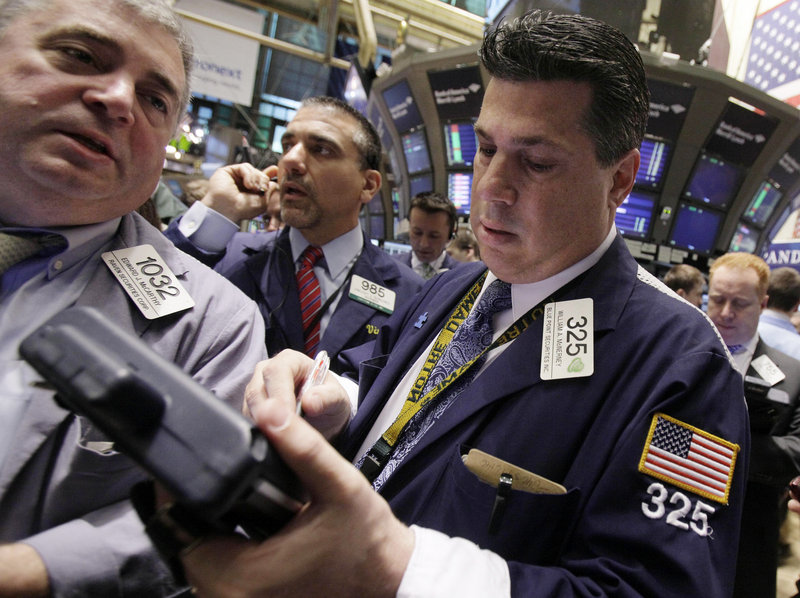NEW YORK – This month may be the slowest in the stock market in more than three years.
Trading volume, or the number of shares bought and sold, is down because there are fewer big investors buying stocks. And those who want to buy are worried about the job market and the European debt crisis — and the budget impasse in Washington. If Congress and the White House don’t agree on budget cuts and raising the government’s borrowing limit, the United States is at risk of defaulting on its debt after Aug. 2.
Daily volume on the New York Stock Exchange is down 22 percent so far in July compared with the same period in 2010, according to data provider FactSet. About 3.7 billion shares have traded hands every day on average, down from 4.7 billion in July last year.
If that continues, July will have the lowest average daily trading volume since December 2007, says Patrick O’Shaughnessy, a research analyst at Raymond James.
Low volume is worrisome because it suggests that few investors are driving the stock market’s gains or losses. That creates the risk for bigger price swings.
When, for example, there are few buyers, someone trying to sell a stock may be forced to keep lowering the price in hopes that someone will want it — the same as a homeowner who can’t find a buyer for a house.
A lack of volume also indicates that some investors don’t believe that stocks are worth buying right now.
“Volume in many respects represents conviction,” says Jack Ablin, chief investment officer at Harris Private Bank. “And there’s just very little conviction.”
Traders have reason to be wary:
• Job growth is weak. Many investors were stunned when the government reported earlier this month that employers created just 18,000 new jobs in June. That was lower than the average of 215,000 monthly jobs created in February through April.
• The manufacturing industry is in a slump, too. The Philadelphia Federal Reserve Bank said last week that manufacturing activity in the Northeast rose only slightly in July after falling to the lowest level in two years in June. Supply disruptions from the March 11 earthquake in Japan have hurt factory production.
• Debt problems remain in the United States and Europe. If there’s no agreement in Washington and the government defaults on its debt, that could have a catastrophic impact on the financial markets. Some analysts say stocks could fall the way they did during the 2008 financial crisis.
All this has led investors to avoid stocks. And that has hurt volume.
In June, investors withdrew $14.5 billion more than they deposited into U.S. stock mutual funds, according to the consulting firm Strategic Insight. That was the largest withdrawal from stock funds since August 2010.
“Investors are running scared,” said Frank Barbera, portfolio manager of the Sierra Core Retirement Fund.
Fewer hedge funds are in existence today than in 2008, which helps to explain the lower volume, says Ryan Detrick, senior technical strategist at Schaeffer’s Investment Research. There were approximately 10,230 hedge funds in the world in the second quarter of 2008, before the financial crisis and stock market crash. By the end of June, there were 9,443, according to the Chicago-based research firm HFR.
Even with the low volume, though, stocks have risen this month. The Standard & Poor’s 500 index is up 1.8 percent, while the Dow Jones industrial average is up 2.1 percent. The technology-focused Nasdaq composite index is up 3.1 percent.
Stocks are up, in part, because companies like Apple Inc. and Coca-Cola Co. have reported strong profits. Second-quarter earnings are expected to rise 12.5 percent from the same period in 2010, according to FactSet.
Still, the low volume makes it difficult for investors to know when to put their money into stocks. If the S&P goes up two days in a row, but volume is low, that’s hardly an indication that a trend is emerging, Ablin said.
Send questions/comments to the editors.



Success. Please wait for the page to reload. If the page does not reload within 5 seconds, please refresh the page.
Enter your email and password to access comments.
Hi, to comment on stories you must . This profile is in addition to your subscription and website login.
Already have a commenting profile? .
Invalid username/password.
Please check your email to confirm and complete your registration.
Only subscribers are eligible to post comments. Please subscribe or login first for digital access. Here’s why.
Use the form below to reset your password. When you've submitted your account email, we will send an email with a reset code.